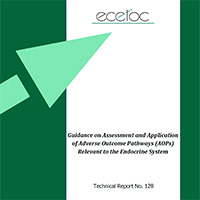Technical Report no.128: Guidance on assessment and application of Adverse Outcome Pathways (AOPs) relevant to the Endocrine System
In a Nutshell
Various European chemical regulations do not allow the marketing or use of substances known to have endocrine disrupting properties – chemicals that induce adverse effects in humans and/or wildlife as a result of interaction with the endocrine system. Adverse outcome pathways (AOPs) have the potential to be important tools for the assessment of endocrine disrupting properties as they can help identify if an adverse effect observed in an in vivo (animal based) study can be plausibly linked to a change in the endocrine system. AOPs could potentially be used to help predict the potential for an adverse effect in humans and/or wildlife from the results of in vitro (non-animal based) assays, potentially reducing the requirement for animal testing. However, if AOPs are to be used to identify and/or predict endocrine disrupting properties, it must be ensured that they are sufficiently robust and fit for purpose. To this end, this Technical Report provides guidance on identifying the basic requirements and how to establish the minimum scientific standards that allow the use of AOPs. The guidance is centred on the different contexts of AOP use such as hazard identification, read-across (predicting potential effects for a chemical based on data for other, similar, chemicals) and risk assessment. These requirements are described as ‘Key Elements in Assessment of AOP Utility’ and cover factors such as ensuring that AOPs are consistent with the current scientific knowledge (Biological Plausibility) and ensuring that any potential differences amongst species are considered (Taxonomic Applicability/Species Concordance). This guidance will be a useful tool for 1) those looking to develop new AOPs helping to identify the key elements that need to be considered during construction, and 2) those considering applying existing AOPs by providing a list of key elements to be considered to facilitate a critical review and ensure it is fit for the intended purpose. READ ONLINEVarious European chemical regulations, e.g. Regulation (EC) No. 1907/2006 (‘REACH’) and Regulation (EC) No. 1107/2009 (plant protection products) only support the marketing and use of chemical products on the basis that they do not induce endocrine disruption in humans and/or non-target species. Therefore, there is keen interest in the development of new tools to help identify and regulate chemicals that may affect endocrine systems.
Adverse outcome pathways (AOPs) have the potential to be important tools for the identification and regulation of endocrine disrupters as they can aid in the determination of the mechanistic basis for adverse outcomes observed in in vivo (eco)toxicological studies; therefore they can help identify if an observed adverse outcome can be plausibly linked to an endocrine mechanism, which is a key requirement for identification of a chemical as an endocrine disrupter according to the widely accepted WHO/IPCS (2002) definition: “An endocrine disrupter is an exogenous substance or mixture that alters function(s) of the endocrine system and consequently causes adverse health effects in an intact organism, or its progeny, or (sub)populations.” They could also potentially be used to help predict the potential for an adverse outcome in vivo based on the results of in vitro mechanistic data.
If AOPs are to be used to identify and/or predict endocrine disrupting properties, it must be ensured that they are sufficiently robust and fit for purpose. To this end, this Technical Report provides guidance on identifying the basic requirements of a defined AOP, and how to establish the minimum scientific standards that allow the use of AOPs in different contexts, such as hazard identification, read-across and risk assessment. These requirements are described as ‘Key Elements in Assessment of AOP Utility’ and each is discussed separately in detail in Sections 2.2 – 2.10. In addition, a case study is presented to provide examples of how these Key Elements may be considered collectively when evaluating an AOP.
Reference
TR128: Guidance on assessment and application of Adverse Outcome Pathways (AOPs) relevant to the Endocrine System ISSN-2079-1526-128 (online) D-2016-3001-247
